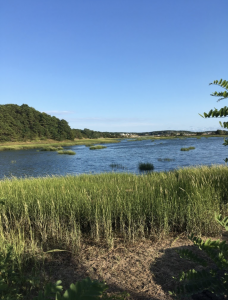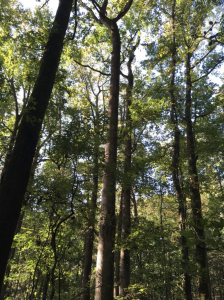
Give (and give back to) the Places you Love!
By Julia Danko, First Year at Oxford College of Emory, majoring in Biology on the pre-environmental engineering track.
During the holiday season, it can feel like life is on fast-forward and you can barely keep up. The month of December is traditionally a busy time, but this year with the pandemic, there is an added uncertainty to the chaos.
But take a breath. Visualize one of your favorite outdoor spots. Maybe it’s the best place for swimming, the spot that has the most beautiful, expansive summit views, or is the home of the most eye-catching flora and fauna; any location that makes you feel alive, allows the rest of the world to momentarily fade into the background.
Now, as we return to the holiday rush, I want to remind you that the “season of giving” is a great time to share and support the natural places we love! All of the habitats that just came to mind are the direct or indirect result of conservation movements, restoration work, and environmental protection policies. There are multiple ways to knit a love for nature into holiday traditions while also reducing waste and emissions in the process (sustainable holiday, anyone?).
First off, gifting experiences rather than objects is an excellent method for eliminating single-use packaging, lowering energy expenditure on shipping, and diverting money from unethical companies. According to the EPA, during the holidays, Americans generate 25% more trash and 33% more food waste than the rest of the year. This amounts to an additional 1 million tons of trash produced each week on top of the 5.5 million tons per week already landfilled. Emory’s Office of Sustainable Initiatives also recognizes December as Conscious Consumer month. By shifting the nature of our gifts from material to experiential we can significantly reduce these figures as well as be more conscious about where we put our money. Planning an outing to a beautiful spot that’s local or within CDC travel guidelines offers the chance for you and the person you care about to get outside and enjoy the picturesque Earth we inhabit!
With this being said, it is also important to recognize that there are dramatic disparities in access to local natural spaces. See this recent report from the nonpartisan Center for American Progress for statistics and more information. But I want to acknowledge that one aspect of climate action is climate justice. Socioeconomic status can trap many people in areas overtaken by pollution or industrialization, thus barring them from the benefits and opportunities that safe and natural outdoor spaces offer. This website highlights some U.S. environmental groups that are working toward a more sustainable and more equal future for our earth.

Another gift option and way to support local and national conservation movements is donating to specific groups or organizations. This site provides a list of 25 national and international environmental non-profits to explore. A quick google search of “conservation organizations [insert state you live in]” produces results for local organizations; they often have information about their specific missions and links to where you can donate. Eco-usa.net also has lists for every state. Making a donation in the name of a nature-lover in your life makes a great gift to them and the planet.
While thinking about giving and appreciation, it is important to recognize and celebrate the great environmental work that is underway within our shared Emory community. Emory is at the forefront of sustainable and restorative land stewardship. The Emory University Forest Management Plan outlines the ways in which the university will continue to work toward its goals “to create, restore, enhance and maintain its forested areas with an emphasis on ecological connectivity, ecosystem function, and native biodiversity.” Emory has been implementing the “No-net-loss-of-forest-canopy” policy (plant new trees every time one is lost) since 1999, the Pollinator Protection Plan since 2014, and continues to support biodiversity on the Lullwater Preserve which is home to 175 species.

The Oxford Nature trail, located behind the Oxford College campus, is the scene of restoration and conservation work during the school year. Work-study students participate in forest restoration by identifying and removing the main invasive species that inhabit the area. Dr. Michael Martin, the overseer of the project, pointed out the benefits of invasive species removal: “next spring new seedlings [will] sprout and now have ample room to grow into the next batch of native shrubs, vines, and trees.” Overall, almost half of the University is protected land and there is a continued focus on maintaining natural corridors to support ecological connectivity.
Despite the pandemic, there are still many things we can be grateful for this holiday season. Maybe start new hiking or outdoor exploration traditions, rekindle your love for nature, or just enjoy the beautiful land, animals, and plants with which we share the Earth!
Sources:
https://www.epa.state.oh.us/pic/facts/holiday
